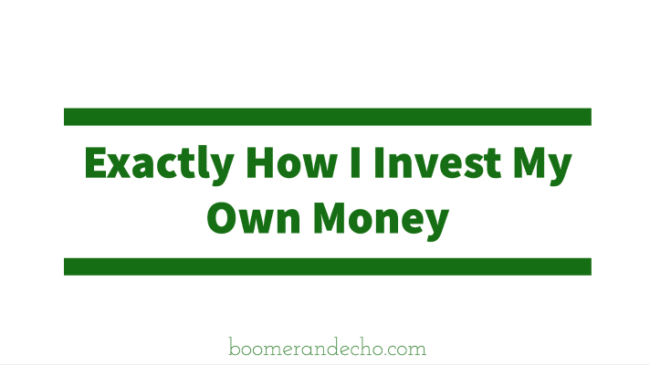How I Invest My Own Money


*Updated for Aug 31, 2024*
Regular blog readers know that I’m a big proponent of passive investing with low cost, globally diversified index funds and ETFs. Why? Low fees are the best predictor of future returns. Global diversification reduces the risk within your portfolio. Index funds and ETFs allow investors to hold thousands of securities for a very small fee.
Investors who eventually come to understand these three principles want to know how to build their own index portfolio. There are several ways to do this: pick your own ETFs through a discount broker, invest with a robo-advisor, or buy your bank’s index mutual funds.
Still, the amount of information can be overwhelming. There are more than 1,100 ETFs, thousands of mutual funds, a dozen or more discount brokerage platforms, and nearly as many robo advisors. The choices are enough to make your head spin.
Must read: Reboot Your Portfolio – 9 Steps to Successful Investing with ETFs
I narrowed these investment options down when I wrote about the best ETFs and model portfolios for Canadians. I’ve also explained how you can retire up to 30% wealthier by switching to index funds. Finally, I shared why you should hold the same asset mix across all of your accounts for maximum simplicity.
Now, I’ll explain exactly how I invest my own money so you can see that I practice what I preach.
My Investing Journey
I started investing when I was 19, putting $25 a month into a mutual fund. When I began my career in hospitality, I contributed to a group RRSP with an employer match. The catch was that the investments were held at HSBC and invested in expensive mutual funds.
When I left the industry I transferred my money (about $25,000) to TD’s discount brokerage platform. That’s when I started investing in Canadian dividend paying stocks. I followed the dividend approach after reading Norm Rothery’s “best dividend stocks” in Canada articles in MoneySense.
I later found dividend growth stock guru Tom Connolly (plus a devoted community of dividend investing bloggers) and started paying more attention to stocks with a long history of paying and growing their dividends.
Five years later I had built up a $100,000 portfolio with 24 Canadian dividend stocks. My performance as a DIY stock picker was quite good. I had outperformed both the TSX and my dividend stock benchmark (iShares’ CDZ) from 2009 – 2014. My annual rate of return since 2009 was 14.79%, compared to 13.41% for CDZ and 7.88% for XIU (Canadian index benchmark).
But something wasn’t quite right. I started obsessing over oil & gas stocks that had recently tanked. I had a difficult time coming up with new dividend stocks to buy. I read more and more opposing views to my dividend growth strategy and realized I was limiting myself to a small subset of stocks in a country that represents just 3-4% of the global stock market.
Related: How my behavioural biases prevented me from becoming an indexer
Furthermore, new products were coming down the pike – including the introduction of Vanguard’s All World ex Canada ETF (VXC). Now I could buy a tiny piece of thousands of companies from around the world with just one product.
So, in early 2015 I sold all of my dividend stocks and built my new two-ETF solution (VCN and VXC). I called it my four-minute portfolio because it literally took me four minutes a year to monitor and add new money. No more obsessing over which stocks to buy or worrying if a stock was going to go to zero.
Fast-forward to 2019 and another product revolution made my portfolio even simpler. Vanguard introduced its suite of asset allocation ETFs, including VEQT – my new one-ticket investing solution.
The next change to my investment portfolio was in January 2020 when I moved my RRSP and TFSA from TD Direct Investing over to Wealthsimple Trade to take advantage of zero-commission trading.
I opened a Corporate Investment Account at Questrade that summer to invest the retained earnings in my business.
I had to open a LIRA in 2020 after leaving my public sector job and receiving the commuted value of my pension. I opened the LIRA at TD Direct for simplicity. The trading fees made no difference since I invested the entire amount into VEQT and didn’t plan to make any changes (and you cannot contribute to a LIRA).
*I’ve since moved this LIRA to Wealthsimple Trade (Feb 2024) when the platform recently made the LIRA, LIF, and RRIF account types available.
Finally, at the beginning of 2022 I sold all of the units of VEQT in my TFSA and transferred the proceeds to an EQ Bank TFSA. It wasn’t about market timing or avoiding bad returns – we built a new house and I used the proceeds to top-up our down payment.
I started contributing to my WS Trade TFSA again this year (2024) and have been buying VEQT.
I’ve written about personal finance and investing for nearly 15 years. Over that time I’ve done an incredible amount of research on banks, discount brokerages, robo-advisors, ETFs, index funds, and investment strategies. I’ve read extensively about behavioural finance and evidence-based investing. I’ve determined that investing in a simple, low cost, globally diversified, and automatically rebalanced portfolio will lead to the best long-term outcome.
I eat my own cooking, so to speak, and invest my own money this way. Here’s what it looks like:
| Account type | Platform | Product | Amount |
|---|---|---|---|
| RRSP | WS Trade | VEQT | $300,709 |
| TFSA | — | — | $0 |
| LIRA | WS Trade | VEQT | $216,848 |
| RESP | TD Direct | VEQT/VSB, XEQT/XSB | $111,860 |
| Corporate | Questrade | VEQT | $357,424 |
I recognize there is no “one-size-fits-all” investing solution. Investors need different products depending on their risk tolerance and stage of life. They use different account types depending on what they do for a living, their tax bracket, cash flow, and available contribution room. They may need to use multiple investing platforms to save in an employer-sponsored plan, to reduce fees, or to open a new account type.
Why Three Investing Platforms?
I’ve banked with TD for my entire life and so it made sense to open my first discount brokerage account there in 2009 at what was then called TD Waterhouse. That’s where I first established my RRSP, TFSA, and my kids’ RESP account.
I moved my RRSP and TFSA over to Wealthsimple Trade when the no-frills self-directed platform added these account types to its line-up. I was attracted to the zero-commission trades and was tired of paying $9.99 per trade at TD Direct. As I mentioned, I recently moved my LIRA from TD Direct to Wealthsimple Trade when that account type recently became available on the commission-free platform.
Wealthsimple Trade still does not offer RESPs or Corporate accounts.
I kept my kids’ RESP at TD Direct, and invested in commission-free TD e-Series funds until January 2024. This year I switched my RESP portfolio to mirror Justin Bender’s RESP approach for a family RESP, basically separating out each child’s share by putting my oldest daughter’s contributions, grants, and growth into VEQT and VSB, and my youngest daughter’s funds in XEQT and XSB.
I’m a big fan of Questrade and what they’ve done for self-directed investors over the past 20+ years. I wanted to try out the platform for myself and had the opportunity to do so when I decided to open a Corporate Investment Account.
ETFs are free to purchase on the Questrade platform and since I planned to add new money regularly it made sense to use Questrade.
Final Thoughts
I write a lot about investing and my philosophy is all about building a simple, low-cost, globally diversified investment strategy. I’ve explained how I invest my own money and apply this thinking to my unique situation. But my situation is not the same as yours.
You may not have the time, desire, or temperament to open a self-directed brokerage account and buy your own ETFs (even if it’s just one ETF). You may feel more comfortable with a digital or robo-advisor guiding the way.
Some of you may not feel comfortable at a robo-advisor and want to remain at your bank. There’s a solution for you, too, in the form of bank index mutual funds.
Some of you may be highly motivated to optimize your ETF portfolio even more by holding U.S. listed ETFs in your RRSP to save on costs and foreign withholding taxes.
The point is that there’s a solution for everyone in today’s investing landscape. I hope that by sharing these strategies, and how I invest my own money, you’ll be able to apply this thinking to your own investments to simplify your portfolio, reduce your costs, and ultimately lead to a better long-term outcome.





